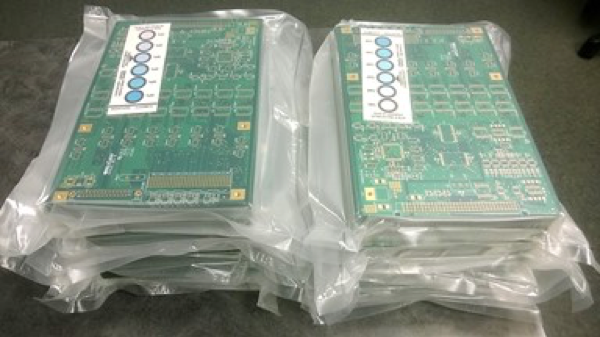|
Dan Jenkins: Tampa, FL Long before electronic surface mount technologies were invented, moisture caused corrosion problems on metallic surfaces. From ancient swords and armor, to Egyptian jewelry to early telephone cable, metal components always want to return to its original state and the oxidation / corrosion problems process began. Early attempts to preserve and protect metal included animal fats, organic oils and coatings made from ashes, minerals and tree sap etc. In today’s world of surface mounted technology, the problems are no different. Metal components are placed in confined spaces and when temperatures change, humidity happens. When this liquid or vapor lands and sits on the metal, general corrosion occurs. Corrosion on boards causes failures, and failures cost the industry millions of dollars to fix. To protect these boards from failure moisture induced corrosion, manufacturers, assemblers and packagers have turned to different technologies to solve this issue. One way is with a conformal coating which is thin film. Often times they work great and there are no problems. Other times, the crack and cause all types of problems, including removal. In this article we will focus on different types of drying agents or desiccants. In another article we will cover other types of corrosion occur such as pitting, galvanic and stress. Let’s start of my understanding what a desiccant is and does. A desiccant is basically a drying agent. Most folks are accustomed to seeing them in pill bottles, vitamins and beef jerky. Today, many in the surface mount technology community are seeing them show up in individually packaged components. One of the reasons for this is the Military Specification D-3464. This specification was written in 1967 with minor revision in 1987….that was a long time ago. This spec calls for a desiccant which acts as an adsorbent, not be confused with an absorbent. While the words sound the same, they have different meanings. An adsorbent works by moisture sticking to the surface of desiccant. An absorbent works by the moisture being soaked up and held by the substrate. A baby diaper works on this principle; however, a baby diaper will not grab moisture from the air. If you get deeper into industry specs and industry standards such as the Joint Electron Device Engineering Council (JEDEC) Institute for Printed Circuits IPC, you will find they too reference the Mil-D-3464 spec, which includes a placement of adsorbent desiccant and a Humidity Indicator Card. So, what’s the problem? If the spec is good enough for the military and good enough for the two leading PCB / electronic associations, why should I care?.....Here is why… The adsorbent, often times referred to as Silica Gel Beads or Molecular Sieves are basically dried sand or Silica, baked in an oven. The baking creates tons of miniature cracks that help adhere the moisture to the surfaces. Sounds great on the surface, but let’s look a little deeper. Disadvantages of Silica GelThere are two main problems. First, due to the material being rigid, the beads do not hold much moisture. So, if your boards are sitting in a hot warehouse or on a ship with lots of temperature changes, the Silica Gel beads can’t handle the volume of moisture and the HIC is triggered. The second main problem is knockoffs and quality checks. Due to the low cost of raw materials, many bags are made overseas and in large volumes which makes quality control difficult. Advantages of Silica GelThey are incredibly inexpensive. A simple 2”x2’ bag can be as low as .25 cents and if you purchase them in China, you can get them for .12 cents. Another advantage of Silica Gel beads are they are treated with chemical dye which will provide a color change to alert the operator when to change out. There are some who claim Silica Gel beads can be regenerated in an oven, but with that low of price, why bother. Advantages of AbsorbentsAbsorbents, such as the Moisture Hog sold by Steel Camel, not only feature an expandable surface to grab more moisture, but they also hold the water by converting water into a non-water element and make it dry. See video youtube.com/watch?v=kli3OMrFUD4) Another advantage of Moisture Hog absorbent is will seek out moisture lurking in the package. Due to these features, the operator will be able to desiccate a much greater volume of air, thus put more board in per package. Often 10 to 15 time more volume. This feature saves labor and packaging material. Another advantage of Moisture Hog absorbent is the change indicator. Instead of a color change, the Moisture Hog bag will change shape and texture. Depending on the situation, it will either blow up like a pillow, or get hard like a rock to notify the operator a change is needed. Disadvantage of AbsorbentsThe Steel Camel Moisture Hog price per bag is more expensive compared to Silica Gel and Molecular Sieves. Often 10-15 times more (which offset by the volume of air desiccated) Another disadvantage is they chemistry cannot be regenerated. Finally, availability. Steel Camel is not Walmart or Amazon. Expect 5-7 days for delivery in the US, 8-12 days abroad. Summary:If you are not having and moisture problems, rejected shipments or component failures due to moisture, stick with Silica Gel Beads and Molecular Sieve adsorbents. If you are having such moisture problems, consider trying the Moisture Hog by Steel Camel…..particularly for your expensive critical moisture sensitive devices. Dan Jenkins, principal at Steel Camel can be reached at 813-877-4665 or [email protected]
1 Comment
10/28/2022 11:03:54 am
It's great that you discussed that absorbents will pursue moisture lurking in the package. My friend told me that their facility needs PCB transformer disposal. I think they should turn to a company that specializes in the disposal and recycling of transformers.
Reply
Leave a Reply. |
�
AuthorIf you have any topics for review, please let us know. Archives
July 2024
Categories |

 RSS Feed
RSS Feed